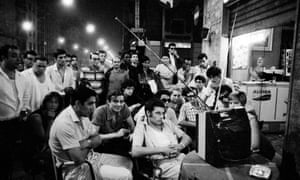On the evening of my sixth birthday I was awakened by my parents in a small motel in Arizona. We were traveling back from a cross country trip to California and Disneyland. My father brought me downstairs to the lobby of the motel to watch Neil Armstrong set foot on the moon.  The lobby was packed with people staring at a fuzzy, ghosted black and white image in anticipation of something that would change the way we think about our world forever. It is hard to relay to someone today in our tech-heavy world how monumental that event was. There were no cell phones, personal computers, or even hand held calculators. Our smartphones contain at least 200 times more computing power than the Apollo 11 lunar module did. Three astronauts calmly climbed into a tiny capsule atop a rocket that produced 7.6 million pounds of thrust (creating more power than 85 Hoover Dams) and propelled themselves 230,000 miles into space toward a celestial body they couldn’t even see (it was a new moon). All of this was accomplished in eight years.
The lobby was packed with people staring at a fuzzy, ghosted black and white image in anticipation of something that would change the way we think about our world forever. It is hard to relay to someone today in our tech-heavy world how monumental that event was. There were no cell phones, personal computers, or even hand held calculators. Our smartphones contain at least 200 times more computing power than the Apollo 11 lunar module did. Three astronauts calmly climbed into a tiny capsule atop a rocket that produced 7.6 million pounds of thrust (creating more power than 85 Hoover Dams) and propelled themselves 230,000 miles into space toward a celestial body they couldn’t even see (it was a new moon). All of this was accomplished in eight years.
The anniversary of the moon landing this past weekend reminded me again of our human potential for good. The Apollo program (1960 - 1973) cost US taxpayers 28 billion dollars (288 billion in today’s dollars), only 2.2% of the total US budget in 1969. In comparison, NASA’s current budget is a mere 0.49% of the total US budget. We committed to spending that money despite simultaneously paying for the war in Vietnam Nam. We accomplished a tremendous feat of engineering, science, and humanity despite the incredible social unrest and political turmoil of the 1960s. As a child, everything was about the Apollo program. My elementary teachers had glossy photos of the astronauts from each mission on the classroom wall. My G. I. Joe dolls had spacesuits and an optional space capsule. Every boy wanted to be an astronaut when they grew up (unfortunately the sixties wasn’t progressive enough to allow a woman or person of color into space). If Twitter had existed then, #Apollo11 would have dominated your feed every day for a year or more.
Today we face an even greater challenge than landing human beings on the moon, but with much more serious consequences. Uniting together and committing to a solution to mitigate climate disruption is the most important and difficult challenge humanity has every faced. This year the average atmospheric CO2 level has hovered around 415 parts per million. That concentration has never been experienced by homo sapiens in the entire history of our species. Every year we see more powerful storms, greater heat waves and more intense forest fires and yet we still resist uniting around a solution. In 1961 when President John F. Kennedy made his famous moon landing speech less than 40% of Americans were in support of such a program. Sometimes doing what isn’t popular is necessary. Today it’s more necessary than ever before. America consumes roughly 18% of all the world’s electricity just behind China (24%) but with less than a third of China’s population. Unlike the Apollo program in the sixties, all of the technology necessary to offset energy consumption in the US is known and readily available. In fact, one of the simplest and most cost effective solutions to reducing consumption is better built buildings. With a unified commitment we could quickly shift to creating better buildings for all our citizens and effectively reduce our energy use by more than 40%. When we challenge ourselves to solve problems we commit both will and resources to those problems. Spending a few billion dollars every year to offset the costs of zero or near zero energy buildings would be a drop in the bucket relative to our $4.407 trillion annual budget.
The lesson of the Apollo 11 moon landing is that our unique gift as Americans is a stubborn resolve a fierce competitiveness. We refused to let the Soviet Union beat us to the moon. Today we could turn that resolve toward China who is already strides ahead of us in terms of their commitment to renewable energy and energy efficiency or even Europe, with its old building stock but advanced Passive Haus construction. Time is running out. We can create our own Apollo program of the 2020s. Let’s return to a hopeful frame like the one that got us to the moon to begin with, and focus on solving humanity’s greatest challenge.